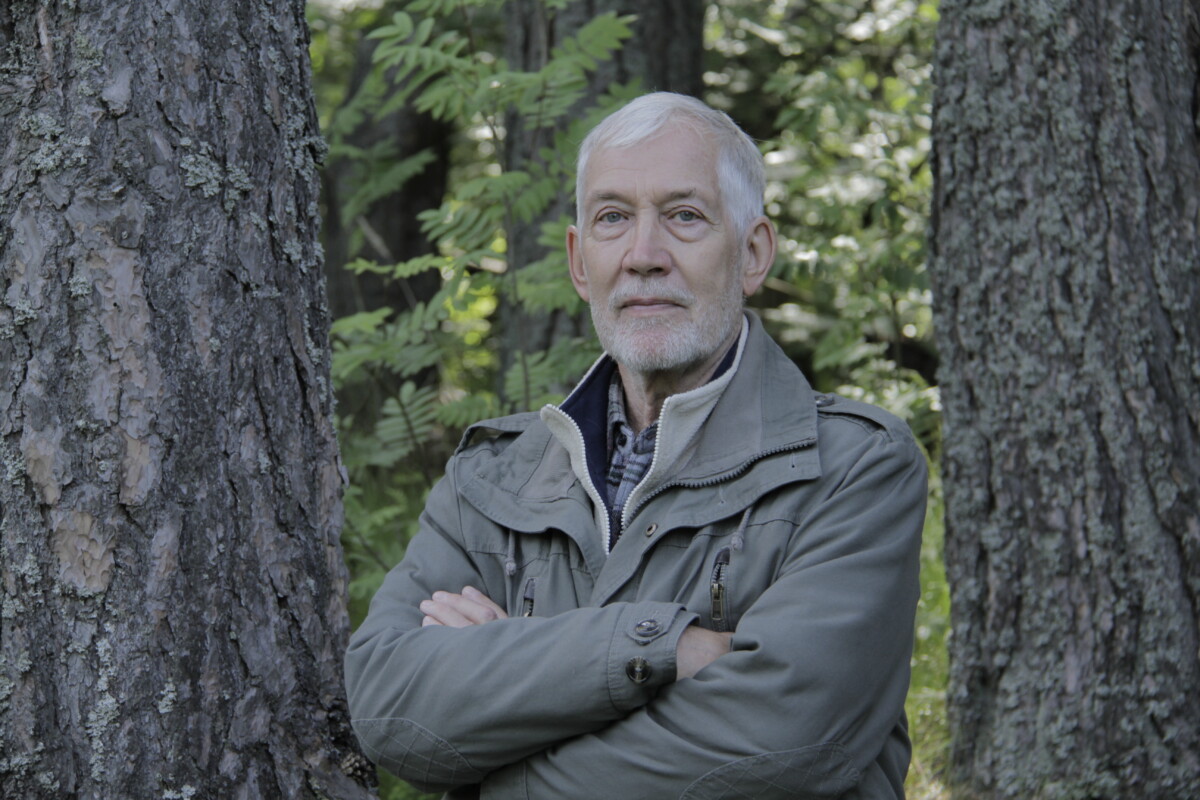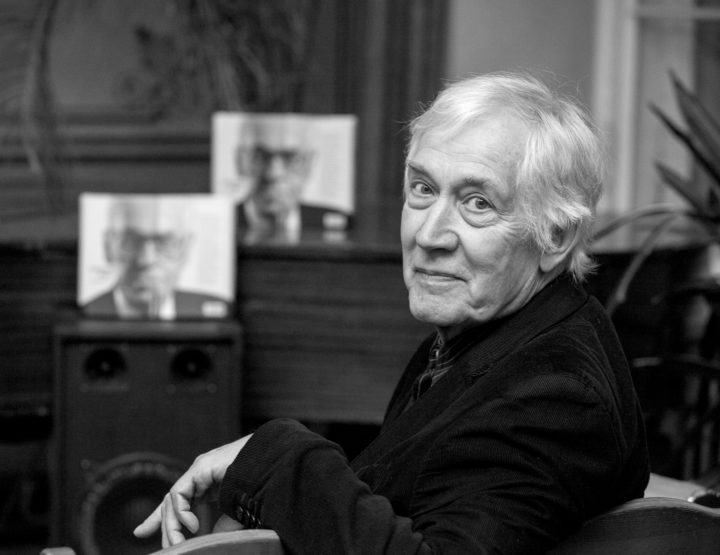Jaan Kaplinski wrote nearly 2,000 poems in several styles and languages over eighty years. The first in his official canon is a ballad titled “The Stranger” (1956), which he penned at the age of 15; while his final poems have not yet been published. Kaplinski’s poetics underwent several transformations throughout his career. As a young man, he wrote melodic, melancholy texts alongside ecstatic free-verse incantations. He endeavored to cast a poetic spell that would separate the ego from the fetters of civilization and achieve broad awareness in space and time.
Kaplinski’s writing expressed interest in Asian thought and ancient history, sympathized with annihilated species and subjugated indigenous peoples living in nature, promoted harmony with the natural world, and cursed Western civilization. His imagery became more austere and exact in the 1970s, his poems frequently being slim pillars of only a word or two per line. Kaplinski’s poetry evolved in the 1980s to capture mundane moments and mediations that wind in unusual spirals from the precise to the universal and back again.
Yet across his wide-ranging catalog, several images and motifs recur. Describing one foundational experience that happened in 1945, he wrote:
I remember it well: I was four years old, sitting on the sofa in our living room on Ülikooli Street, and this strange thought suddenly came to me; one I couldn’t articulate then and still cannot now. It was something roughly to the effect of: ‘How is it that I am me, that I am here, that I am J. K., and I am four years old?’ I knew that I was J. K., but realized that I cannot fathom being J. K. and being me.
From then on, Kaplinski was haunted by an astonishing revelation: how could he, one of innumerable living beings, call himself “I”? Recognizing that the ego or self is separate from everything else is an experience that many metaphysically minded individuals have before adolescence. For some, it fosters self-involvement, for others, self-hatred. Some turn to drugs to try to forget it; in many societies, it is a subject of professional philosophical research. There are ample ways to express and act upon the astonishment and quandary that exist in religion and in art.
In both life and poetry, Kaplinski perceived the being of self as a burden or hobble that limits one’s cognition of the world. He detested anyone’s attempt to classify, define, or judge him by his past works and deeds. To foil such bids to box him in, motivated by an inner need for change, Kaplinski constantly switched genres, interests, and manners of observation. Nevertheless, there was something lasting within this change. He maintained awareness of his own alienness; of being an involuntary guest in this country, climate, and world, yearning to return to his true home.
Like other existentialists, Kaplinski believed that wrestling with great unanswerable questions is a defining element of the human condition:
To a child, questions of life and death, the meaning of life, ego, time, and eternity are real and daunting. Sometimes, I think that the accumulation of these challenging and unanswerable questions is one of the reasons why a child grows to become an adult. […] Man is born as a question, metaphysical and existential. A question, meaning the search for an answer; the quest for a solution to things we all encounter: problems, concerns, contradictions. An answer to why life can only lead to death; to how someone must be precisely the person they are and bear a single fate.
These questions arise from the clash of the self with reality and do not dissolve into final answers. Rather, they inflicted almost physical pain upon Kaplinski. As he wrote in a poem:
Some of my poems are answerless questions.
Others are questionless answers.
In a later Russian-language prose poem, he even questioned the point of questioning itself (at least in art):
I realize that if we are honest, then we always have more questions than answers. Occasionally, I’d still like to ask: what good is a question? Perhaps we don’t need them at all. And I regret that many of today’s artists are concerned more with questions (particularly those that do not and cannot have answers) than they are with beauty.
Splitting original experience into question and answer generates a thirst for reconciliation; for comprehending the world and fostering mutual understanding between people. The first can be achieved through self-dismissive ecstasy, such as in Kaplinski’s (in)famous invective of Western civilization titled “I GOT IT I GOT IT”. Connecting to another person is much more complicated. Among the plethora of great metaphysical questions is doubt over whether people are actually soulless automatons or zombies:
two young female corpses stand beneath a birch
chatting and understanding nothing
Longing for understanding and knowing that this action is futile fascinated Kaplinski in his younger years:
for the answer is not a bridge
but rather burning bridges
He used the question/answer dialectic to portray the relationship between man and nature:
the color red is a question the color green is an answer
(Here, the colors represent a blood-soaked battlefield.)
Question and answer are like a conceptual rhyming pair that permeated Kaplinski’s poetry from the beginning to the very end. But not only: many other conceptual echoes and contrasts resonate throughout his catalog. They function as “mute rhymes”, though in some cases, their Estonian counterparts also rhyme acoustically. One example is veri and meri, blood and sea. Kaplinski used them to emphasize the horizontal belonging of all living beings; how the souls of humans and every other creature will one day break down into fundamental elements; how every living being is made up of atoms that once comprised other bodies that were animated by another soul. The idea of cyclical dissolution and formation is expressed in his recurrent contrasting of dust and butterfly wings; of fire, coal, and ash; and of phoenix, wings, and feathers. It evokes lines from Vladimir Nabokov’s “An Evening of Russian Poetry”:
The rhyme is the line’s birthday, as you know,
and there are certain customary twins
in Russian as in other tongues. For instance,
love automatically rhymes with blood,
nature with liberty, sadness with distance,
humane with everlasting, prince with mud,
moon with a multitude of words, but sun
and song and wind and life and death with none.
Kaplinski’s poem “The Same Sea in Us All” was inspired by maritime researcher Hans Hass’s book We Come from the Sea. In it, Hass describes how blood originates from the waters of primordial oceans and shares with them, to this very day, a similar chemical composition. Kaplinski was likewise intrigued by Hungarian psychoanalyst Sándor Ferenczi’s theory about a human desire to return to the waters of the womb, which in turn reveals a desire to spill back into the primordial oceans. For human beings, the process of birth possesses the same ontogenetic trauma as life’s phylogenetic transition from water to land. Even sexual pleasure is tied to “thalassic regression”: a longing for the sea we left behind millennia ago. One question that hangs suspended over Kaplinski’s poems comes from François Villon: “Mais où sont les neiges d’antan?” Where are the snows of yesteryear?
His entire catalog is pervaded by a yearning to go back somewhere; a desire to call something back; sadness over the impossibility of turning things back; and noticing something that perpetually comes back, or at least a hope that it will. The word, or a version of it, even appears in many of his collections’ titles. Commenting on the poem “The Soul’s Return”, he remarked:
It is like one great return, one great flow back to the beginning. Our culture is obviously dominated by forward progress. But in Taoism, there is also the reverse: there are strong trends of anti- or counterculture within culture itself, an attempt to socialize asocial behavior. This exists even at the physiological level, such as exercises that seemingly aim to return one to the embryonic state.
It is true, however, that Kaplinski never yearned to return to the recent past. On the contrary:
Neither am I fond of returning
to a lived life, to an extinguished flame,
to a considered thought, to a written poem.
This yearned-for beginning is sometimes embodied by the Tertiary: a (since obsolete) geological period after the dinosaurs and before the last ice age, during which Eurasia was covered by lush flora, saber-toothed tigers roamed the continent, and the ancient pines that produced today’s Baltic amber flourished. Amber’s glow indeed reflects that bygone time, preserving primeval light for us to marvel.
As such, another conceptual rhyme in Kaplinski’s poems is algus and valgus, beginning and light. Light is what guides the soul back to the genesis of all things. And vice-versa: we yearn for the beginning because that is the place of light, peace, and joy (as in Baudelaire’s country of Cockaigne: luxe, calme, and volupté). The vertical axis of beginning and light intersects the vertical axis of blood and sea. In some of Kaplinski’s poems, yearning for the former is associated with the gnostic conception of the human soul as a seed of light imprisoned in the material world, and its potential to grow back towards that light. These themes intensify in his later Russian-language poetry, along with concern for the soul’s posthumous fate.
Kaplinski was a trained linguist and ruminated extensively on language. A third conceptual rhyme in his poetry is thus keel and meel, language and mind. It indicates an understanding that the tendency of language and words to divide the perceptible world into discrete units cannot keep up with the flow of experience, and distorts our true, boundless reality. This goes hand in hand with a fourth rhyme: silm and maailm, eye and world, which stresses that the latter concept exists only as it is perceived – a world that is for someone or viewed in someone’s eyes.
A fifth oblique, metaphorical conceptual rhyme is uni and muna, dream and egg. Kaplinski used it to convey an expectation of radical rebirth: an image (like that of a dream before waking) of human existence in this world as unhatched chicks pecking impatiently at the inside of their shells, waiting for true birth. A sixth conceptual rhyme that holds his poems together is hing and ring: soul and circle, which expresses the soul’s longing to escape the wheel of earthly things, as well as an understanding of the soul’s cyclical outward journey and return through reincarnations. And as one final conceptual rhyme for this essay: luule and tuul, poetry and wind – an understanding of inspiration that nourishes both as divine breath.
These conjectures about Kaplinski’s conceptual and sometimes acoustic rhymes are admittedly speculative but might help identify the secret threads that hold together his complete oeuvre: both the sublime, ecstatic poems as well as the more mundane and quotidian examples.
Zbigniew Herbert, one of the great postwar poets (who had quite a contrasting temperament), began an epistle to his colleague Ryszard Krynicki as such:
Not much will remain Ryszard in truth not much
of the poetry of our mad century Rilke Eliot sure
a few other worthy shamans who knew the secret
of word spells time-resistant forms without which
no phrase deserves memory and speech is like sand
We may certainly count Kaplinski among the worthy shamans who knew the secret of spellcasting, and whose invented phrases help to keep our language vibrant and intact.





